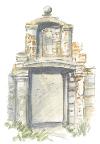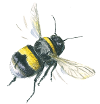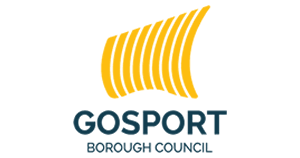The Hermitage Wildlife Garden
The Hermitage Wildlife Garden
The garden is situated between Kingston Road and Newport Road, off Southcroft Road, in the Anns Hill area of Gosport.
The Origins
From Victorian times the land was used as an orchard and market garden, and was part of the Hermitage House. In the 1980's the orchard became overgrown and the land was sold off for development. The house remained separate. Following a lengthy campaign by local residents and Gosport Borough Council the land was saved from development and in 1995 it became a protected Open Space owned by the Council.
In November 1995, a group of local volunteers 'The Friends of the Hermitage' started clearing the site with the help of the Countryside Section of Gosport Council and the H.M.S. Sultan community service groups. Since then a series of habitats have been created to attract wildlife to the area. A pathway has been constructed around the site.
Grants have been obtained from the Hampshire Community Action Fund, Gosport Borough Council, British Telecom and the Shell Better Britain Campaign. Many individuals have made donations and the 'Friends' hold fund raising events.
Why a Wildlife Garden?
The garden provides a natural green space for local people. A place of rest and relaxation which enables people to connect to nature and their local environment.
The development of the wildlife garden centres around four main principles.
1. The growth of wildlife friendly flora, some native species. Plants provide the start of the food chain which supports wildlife. Our native animals are adapted to eating our native plants. The Oak Tree supports 284 insect species and the Hawthorn 150.
2. Allowing for decay. A number of mammals and invertebrates benefit from wood piles and old leaves left to decompose. More creatures eat dead or rotting materials than living so it is important to allow things to decay.
3. Providing lots of breeding sites. Wood piles provide homes for Wood Boring Beetles and Wood Wasps as well as encouraging various fungi to colonise. Stag Beetles rely on decaying wood as the larvae feed on the wood at, or just below ground level for about four years. They then pupate and emerge the following May or June as adults. Our largest beetle is about 7cms. Nest boxes provide the increased opportunity for Blue Tits, Great Tits, Sparrows and Robins to breed. The dense bramble undergrowth is also a great attraction for many other birds including Dunnock and Blackbird
4. Creating a variety of habitats. A woodland edge of mature oaks already exists and this has been supplemented by underplanting with species such as Bluebells, Primroses, Foxgloves.
The pond and bog garden increases the opportunity for wildlife, water being essential for all life. A great variety of plants and animals exist in this small oasis. The hedgerow will provide berries for birds, leaves for caterpillars and other insects, as well as protection for nesting birds such as the Song Thrush and Blackbird.

The History
The Legend
The area of the Hermitage has always been surrounded by myth and legend. Stories of monks, ghosts and tunnels firmly established in local memory. It was once thought that the site was a monastic settlement or grange attached to Quarr Abbey in the Isle of Wight. If this proves to be true it is possible that a small community of monks occupied the site to look after St. Ann's Well, which was in Brockhurst Road opposite the junction of Ann's Hill Road. The local artist, Martin Snape, said in one of his lectures on 'Old Gosport', the name could have derived from 'Tarna', a Saxon goddess, who presided over medicinal springs and that when the area was converted to Christianity it was changed to 'St. Ann'. It was still in existence in 1859 as there are letters in the Hampshire Telegraph asking for it to be restored. The footpath, once leading from the Hermitage directly to the 'Annswell' area, traditionally said to be the 'monk's path', is now partly followed by back ways and alleys. No confirmation of these legends has been found but research continues.

Archaeological Discoveries
In the early 1930's, two brothers, Maurice and Leonard Edwards, were laying pipes in Southcroft Road for the Gas Board, when they broke into a tunnel, this could have been a tunnel that was said to have started at the Hermitage, the first part of which was used to store garden tools. Also in the 1930's a new orchard was being planted in the Hermitage and some mosaic floor tiles were found. Unfortunately nothing was recorded about them. During the construction of the present Wildlife Garden the following items were found and have been identified by the Hampshire County Museums Service as:
George I half penny 1714 - 1727
Glass fragment; apparently gilded, 16th century or earlier imported vessel
Fragment of Spode meat dish of about 1812
Fragment of moulded lattice and feathery palm pattern Staffordshire creamware c. 1750
Fragment of tile, 18th century Dutch Delftware
Goblet stem and foot: modern, moulded rather than thrown, 1950-1960
When the new pond was excavated, a quantity of oyster shells were uncovered. This could indicate the presence of a medieval midden although without any other finds of a medieval date it is impossible to say. A millstone, almost certainly from Brockhurst Mill, a stone slab covering the inspection chamber of a well, believed to be 17 feet deep and two large dressed masonry blocks, complete with holes for iron hinges, have unfortunately disappeared during the landscaping of the garden.
The Land
On the first surveyed map of Gosport by the Board of Ordnance in 1774 the whole area lying either side of Anns Hill Road is shown to be farm land. A lane (now Middlecroft Lane) is clearly marked, with a right-angled turn leading down to where the Hermitage is today. The original site was much larger at that time, approximately 4.5 acres, which extended to the Alverstoke/Rowner Parish boundary, still marked today by a footpath and the fence line for H.M.S. Sultan.
Around the end of the 18th century the Hermitage land appears to have been to have been purchased by John Collins, a prosperous builder/brick maker. The land was to remain in the same family for over one hundred years. Part of the site seems to have been excavated for 'brickearth' and a lower level of ground is still noticeable today. This was probably when some evidence of a monastic settlement was discovered and the legends began. By 1809, when John Collins made his will, he refers to "....my parcel of land with Brickkilns and all other Erections and Buildings". It is clear that at this time it was a small but busy industrial site. It is thought that the present house (now in private ownership), dates from the early 1800's. Nothing remains of the earlier buildings built by John Collins and his family although there is a description of them in a letter written in the 1930's;- ".....the building being all on one floor consisted of from 16 to 20 rooms in the middle of which was a long room used as a chapel it had coloured glass doors one end and coloured windows the other, with effigies on the ceiling and little Madonnas etc. in little alcoves in the wall".
By 1857 the ordnance survey map shows this 'long' building and what looks like a garden, it is also now called 'The Hermitage', it also shows an orchard planted on the east side of the garden next to the lane and other trees around the house. On the 1841 Tithe Map, the two parcels of land to the west, abutting on the Parish Boundary, are registered as arable. Thus the Hermitage appeared to be a 'small holding' and was to remain so until after the Second World War.
John Collins' granddaughter Maria Vigar died in 1884 and the property was taken over by John O'Halleran Webb, a master miller, from Middlesex who had been living at the Hermitage for over ten years, as shown by the 1871 and the 1881 census returns. It would seem that he took over as miller of Brockhurst Mill from George Vigar, during that time. (John Vigar had died in 1854 aged 62). By the 1891 census, John O'Halleran Webb had married Marian Bishop, a widow with a young son, whose mother was a lodging house keeper, at Queens Terrace, Forton Road. Mr Webb served on the Local Board, for the North Liberty Ward for 1893 and 1896. Between 1896 and 1901 Mr Webb died and by 1907 Leopold Jerome is listed in Kelly's Directory as the owner. Mr Jerome, in a letter to Mrs. E. Kentfield in the 1930's says that Mr Montague Foster purchased the Hermitage from Mr Webb's executors and presumably this is when the two larger pieces of land to the west were separated from the Hermitage and its garden. In the early 1930's Mr. A. White started to build the Southcroft Farm Estate and gradually the Hermitage became surrounded by development whilst retaining its rural aspect and tranquil atmosphere which it still has today.
The Family
John Collins, was a prosperous builder and brickmaker. He owned property in Gosport town area, in Elson and Forton Road. He owned a pew in the 'chapel of Gosport', now Holy Trinity, a property and garden in Alverstoke and a 'parcel of land with the brickkilns and all other Erections and Buildings' also in Alverstoke. Also mentioned in his will are bequests of 'silver plate' and 'china'. As far as is known John Collins had three children, James, Jane (who married James Stone), and Mary who married William Vigar, the miller at Brockhurst Mill.
John Collins died in January 1818 and it is probable that Mary and William moved in with Mary Vigar's mother, also called Mary. Sadly, William died on the 10th of May of the same year, leaving Mary with twelve children to bring up, the youngest being only two.
In April 1825, one of their sons, Uriah, then aged 18, was tried at Portsmouth Quarter Session and transported to Tasmania for seven years, "........ for stealing a large quantity of silks, sarsnets and etc...... the prisoner's brothers, William and Thomas, were also indicted, a quantity of the silks having been traced to have gone through their hands, but they were both acquitted from want of jurisdiction, they being residents at Gosport where the property was found..." Uriah served his term and worked for the Government as a clerk in the Engineers' Barracks, Hobart. He then settled in a property at Pittwater, Hampden Park, Tasmania. By 1840 three of Uriah's brothers had arrived as free settlers, James, Frederick and Thomas. In 1843 Uriah married Maria Stanfield, they had a daughter, Mary, born in 1844. Uriah died in 1846 and his widow Maria, married his brother Frederick, who had also bought land in Tasmania, at Forcett. Thomas was a miller like his father and owned the Cascade Flour Mills in Hobart, he died in 1850.
William Vigar had left the Hermitage to his wife Mary, and their son John followed his father as miller at Brockhurst Mill. John Vigar seems to have been a man of some importance in the town. He was annually appointed as Hayward for Alverstoke from 1835 to 1850 by the Alverstoke Court Leet. He owned Brockhurst Mill with its shop, bakehouse, piggeries and stables, and Vigar's Cottages on the corner of Mill Road and Forton Road. The family also had an interest in 48 High Street, Gosport, which was a corn merchants, grocery and tea dealers. The premises in 1999 being the Oxfam Shop. In the wall of the building fronting the alley can be seen signs of an upper corn-loft, where sacks would have been hoisted up.
The Vigar brothers seem to have had the reputation of being 'hermits', but they obviously inherited their grandfather's skills as a builder as they made stained glass and statues and some of their work was said to have been used in windows in the old St. John's Church, Forton and St. Matthew's Church, Gosport.
It has also been said that they were Catholic refugees from Holland, but this is a mystery, because they were all married and buried within the Anglican Church and the children were baptised at Holy Trinity, Gosport. In the 1790s a large number of refugee French Priests entered Gosport as a consequence of the French Revolution. Due to such large numbers, the Catholic Priests were housed with local families and the Government opened the disused Forton Gaol to accommodate them. It is possible that the chapel and the sixteen - twenty rooms at the Hermitage were built at this time, taking advantage of a need and to provide extra income for Collins and Vigar families. Perhaps this is the foundation of the legend about the family being Catholic refugees.
Mary Vigar died on the 1st February 1854 aged 84 and is buried at Anns Hill Cemetery. She left all her property to her daughter Maria and after her, to her son George. John Vigar died ten months after his mother on the 27th December 1854 aged 62 and he is buried in the churchyard at St Mary the Virgin, Rowner. George and Maria lived on at the Hermitage for a further thirty years. On the 1861 census return, the entry shows two households, Maria Vigar, aged 60, still unmarried and her brother George aged 50, corn miller and Rosetta Watson, aged 13 domestic servant. The other household shows Frederick Vigar aged 55, land proprietor and Maria his wife aged 43, born in Tasmania! It is not known how long Frederick and Maria stayed as they do not appear on the 1871 census, but it is nice to know that one of the brothers came back from Tasmania to visit his birthplace.
By the 1871 census Maria and George now have a 'boarder' , John O'Halleran Webb, a master miller, born in Middlesex. George had obviously retired and John Webb had taken over the mill. They still had 'Rose' Watson, the domestic servant and also William Goff, aged 15 another servant. The 1881 census shows them all ten years older but no servants are mentioned. George died in March 1883 aged 81 and Maria died in October 1884 aged 86. They are both buried at St Mary the Virgin, Rowner. Thus ended over one hundred years of ownerships of the Hermitage by the same family.
The Pond
The pond is a centre for wild-life activity. Its sunny location and its diversity of plant life provide a haven for an enormous variety of creatures. Some are totally dependent on the pond for all of their life cycle such as Greater Pond and Ramshorn Snails. Others, generally predators, fly between bodies of water like the adult Great Diving Beetle, Pond Skater and Water Boatman. Yet other animals spend their immature stages underwater only to metamorphose into Dragonflies and Damselflies.
There is a range of depths from the shallow edge to 75cm. in the centre. This attracts a variety of pond creatures and also provides opportunities for different plant species to colonise.
A gently sloping edge allows easy access for amphibians such as frogs, toads and newts and also allows birds to drink and bathe.
The paved front edge allows children to watch the activity in the pond without damaging the marsh plants.
Dense planting around the back of the pond provides cover and shelter to animals entering and leaving.
No fish have been put in the pond as these would eat the other life and so reduce the wildlife value.
Some plants you will see around the pond include Water Mint, Purple Loosestrife, Yellow Iris, Marsh Marigold, Water Violet.
Some of the animals that you may see depending on the time of the year include Frog Tadpoles, Newt Tadpoles, Frogs, Toads, Common or Smooth Newt, Greater and Lesser Water Boatman, Great Diving Beetle larvae and adult, Whirlygig Beetles, Pond Skater, Water Measurer, Leech, Emperor Dragonfly nymph and adult, Broad Bodied Chaser nymph and adult, Common Damselfly nymph and adult, Backswimmer, Water Louse, Daphnia, Ramshorn Snail and Greater Pond Snail
Water Boatman or Backswimmer can row at speed and is a predator of the pond, eating Tadpoles and other Boatmen.
The Great Diving Beetle is a giant among pond creatures. It has powerful back legs for diving and it is a voracious predator on any other creatures in the pond.
The Common Blue Damselfly flies from May to October and preys on small insects. Look for the larval cases on the emergent pond vegetation around the pond edge in May.
Water Fleas or Daphnia make a rich soup in the pond providing everyone else with dinner.

The Meadow
Mowed in June and again late October. This is to encourage the spring flowers to bloom and the allowed to set seed.
Rough grassland is present and seasonally dominated by Cow Parsley which provides invaluable nectar and pollen resources for a number of invertebrates. Hawthorn Mining Bees have been seen nectaring here. This can sometimes be regarded as unkempt by members of the public. There is also a good amount of ivy present at ground level offering another feeding resource for birds and bees.
Other wildlife seen in the meadow include Ground Beetles, Ladybirds, Earwigs, Red Ants, as well as Butterflies and Moths. You can occasionally hear the arguments of Shrews as they meet, or the rustling of a Bank Vole.
Grasses tend to be overlooked, but you will notice the variety here and you will see how delicate and attractive they are. They are often the food supply of Caterpillars such as the Meadow Brown and Gatekeeper.





